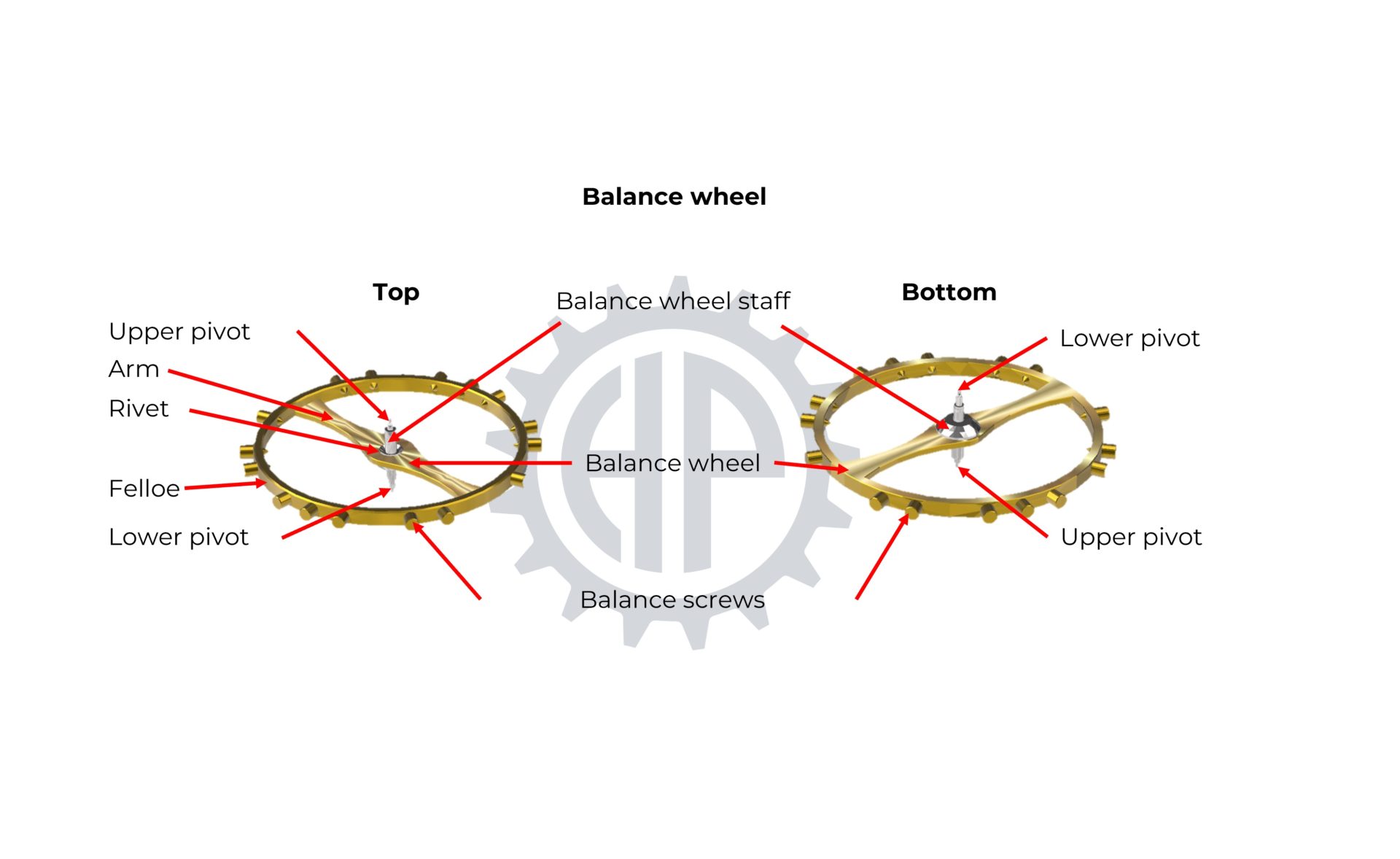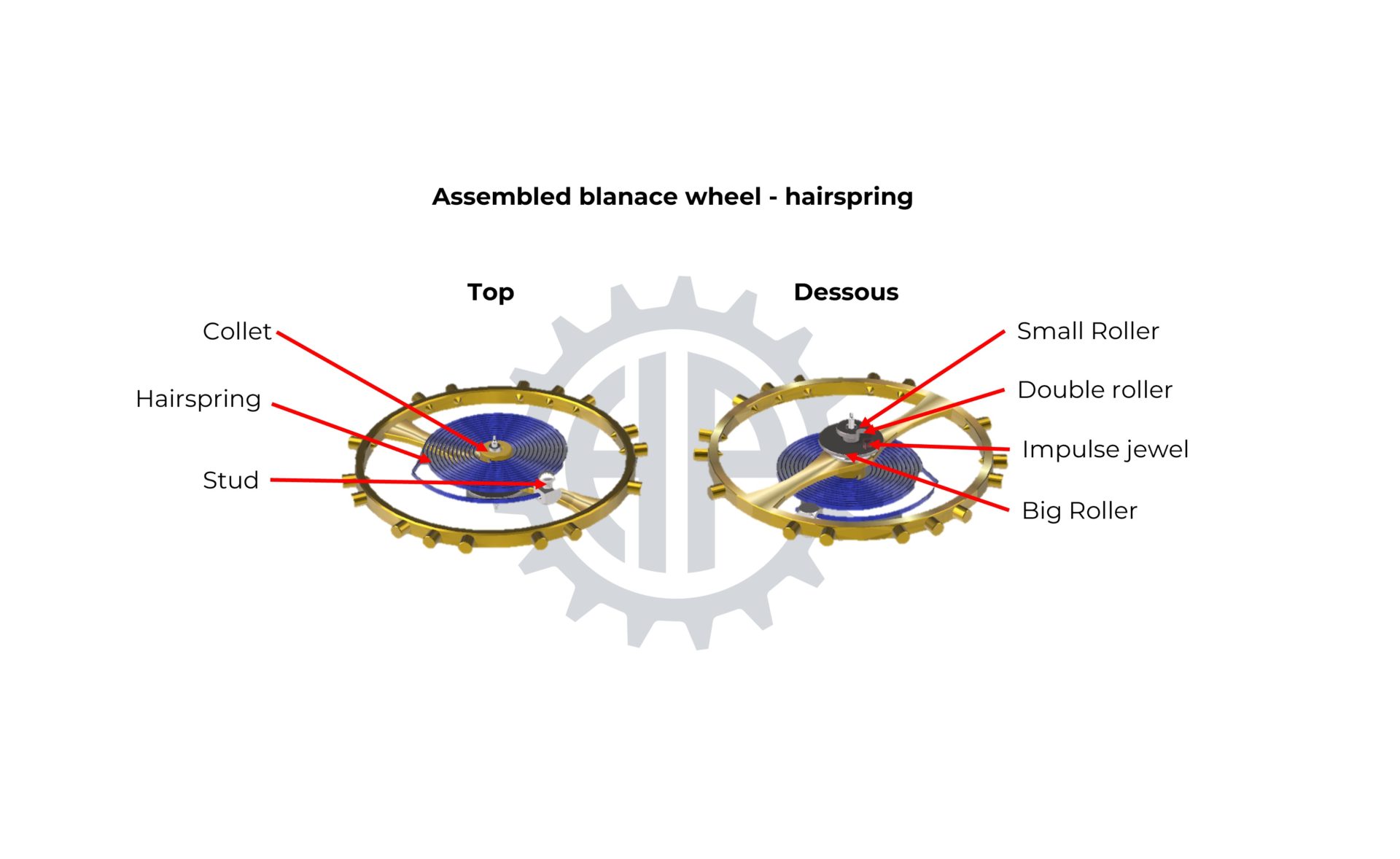The balance wheel of a watch and the hairspring constitute its regulating organ.
The balance wheel is a large wheel with the greatest possible inertia to limit the influence of external factors (shocks, lubrication, etc.). Various alloys can be used for its fabrication. Ideally, maximum inertia and the lowest expansion coefficients are sought. Temperature changes alter the moment of inertia of a balance wheel due to the expansions and contractions of the material, with potentially detrimental effects on the timekeeping of a watch. Historically, these technical deformations were compensated by manufacturing split bimetallic balance wheels. One metal compensates for the deformations of the other, ensuring that the moment of inertia of the balance wheel (and hence the watch’s regulation) remains as stable as possible.
Typically, the balance wheel has only two flat arms. The peripheral ring of the balance wheel is called the felloe. It may, in some cases, feature weights or screws for balancing and adjustment by modifying its moment of inertia. For optimal adjustment, the balance wheel must be perfectly balanced. The balance wheel is riveted to the balance staff (made of steel), on which the double plate (an element of the escapement) and the hairspring are also fixed. Then, the assembled unit is rebalanced.
To minimize friction points, the pivots of the balance staff are conical and have a very small diameter (often less than 0.10mm). The high mass of the balance wheel and the small diameter of its pivots make them very fragile. This is why the use of shock absorbers became widespread during the 20th century.
Christian Huygens, a Dutch mathematician, astronomer, and physicist, contemporary with Galileo, with whom he shared certain subjects of study (astronomy, pendulum), discovered in December 1659 the theory of the isochronism of the cycloid. According to this theory, the period of a pendulum is constant, regardless of its amplitude, when the end of the pendulum moves in a cycloidal path. This theory still governs all calculations related to the regulation and precision of clocks and watches to this day. Huygens is also known for being the first to associate a flat hairspring with a rimmed balance wheel. An invention that allowed the development of travel clocks (marine chronometers) and later wristwatches.
Although many attempts and research have been made to imagine more efficient mechanical oscillators (in precision, frequency, etc.), Huygens’ invention remains unbeatable to this day.
Watchmakers quickly understood that two of the factors most disrupting the accuracy of a watch are gravity and temperature differences. To compensate for the effects of gravity Abraham-Louis Breguet invented the tourbillon in 1801. To combat expansion due to temperature changes, watchmakers devised split bimetallic balance wheels. The expansion of the first metal being mechanically opposed to that of the second metal results in thermal compensation, with a minimally modified moment of inertia of the balance wheel. This type of balance wheel disappeared in the 20th century following the invention of the Invar alloy in 1907 by Charles-Edouard Guillaume. This iron and nickel alloy has an extremely low expansion coefficient. It found numerous applications (metrology, cryogenics, watchmaking, etc.) and even contributed to the invention of television, earning Guillaume the Nobel Prize in Physics in 1920.
Balance wheels made of this 64% iron and 36% nickel alloy undergo such negligible thermal influence that they will revert to a monometallic composition and a rimmed shape. Since the early 21st century, new materials have appeared and are sometimes found in the composition of balance wheels.
The inertia of a balance wheel must be located as much as possible at its periphery, while its centre must be as light as possible. Therefore, one may find balance wheels made of titanium (non-magnetic, robust, lightweight, and low-expansion metal) with gold masses on their felloes.
Two components make up the balance wheel: its rim and its staff. The staff is made of steel and can be easily produced on a watchmaker’s lathe and a manual pivot lathe. For the rim, turning operations can be performed on a lathe or a face-lathe. The cutting of the arms can be done manually with a piercing saw. Once the rim is made and decorated, the watchmaker rivets it to its staff in the same way as a wheel plate to its pinion, then balances the assembly for the first time by milling some material under the balance wheel’s rim where the unbalance is located. The balance wheel as such is then completed. However, for it to function, it must still be assembled with the double roller, which is driven under the balance wheel directly onto its staff, while the collet of the hairspring allows fixing it above the balance wheel. The assembled escapement must be rebalanced before it can be integrated into the complete movement and then proceed to the regulation of the watch.
On an industrial scale, the rim of the balance wheel and its staff are generally machined by an automatic lathe. In addition to the turning operations inherent in these two components, milling of the arms can also be performed on the same machine. In this way, all turning and milling operations are perfectly concentric, and the balance wheel is better balanced. The methods chosen for finishing, decoration, assembly, and balancing operations are then selected based on the watch’s range (hand polishing or drum polishing, hand or machine rolling, etc.). As with each manufacturing method, the balance wheel is calibrated upstream and downstream of each assembly operation.
There isn’t a pure hi-tech method employed in the manufacture of balance wheels. However, certain elements of the balance wheel (e.g., weights on a rim) can be made from hi-tech materials (e.g., silicon). In such cases, this will involve the use of processes coming from the latest technologies (photolithography).


